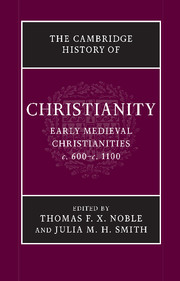Book contents
- Frontmatter
- Introduction: Christendom, c. 600
- Part I Foundations: Peoples, Places, and Traditions
- Part II Christianity in Confrontation
- Part III Christianity in the Social and Political Order
- 12 The Christian church as an institution
- 13 Asceticism and its institutions
- 14 Law and its applications
- 15 The problems of property
- 16 Ideas and applications of reform
- 17 Churches in the landscape
- Part IV Christianity as Lived Experience
- Part V Christianity: Books and Ideas
- Conclusion: Christendom, c. 1100
- Bibliographies
- Index
- References
17 - Churches in the landscape
from Part III - Christianity in the Social and Political Order
Published online by Cambridge University Press: 28 March 2010
- Frontmatter
- Introduction: Christendom, c. 600
- Part I Foundations: Peoples, Places, and Traditions
- Part II Christianity in Confrontation
- Part III Christianity in the Social and Political Order
- 12 The Christian church as an institution
- 13 Asceticism and its institutions
- 14 Law and its applications
- 15 The problems of property
- 16 Ideas and applications of reform
- 17 Churches in the landscape
- Part IV Christianity as Lived Experience
- Part V Christianity: Books and Ideas
- Conclusion: Christendom, c. 1100
- Bibliographies
- Index
- References
Summary
The Cluniac monk Rodulfus Glaber (d. 1047) owes his renown as a historian to his near-obsessive interest in all of the remarkable events that occurred around the turn of the first millennium after the birth and passion of Christ. He recorded various signs of the unraveling of a decrepit world: comets; famines; blood falling from the sky; the apostasy of Christians converting to Judaism; Norman, Hungarian, and Saracen invasions; the destruction of the Church of the Holy Sepulcher in Jerusalem; waves of heretics. Conversely, Glaber also found signs announcing a new covenant between God and his faithful people – traces of a veritable renewal of the world. It is worth noting that the proofs of this rebirth all evinced a strong connection to this world: the finding of relics; peace councils and the creation of violence-free zones; the construction of a “white mantle of churches”; pilgrimages to holy sites; the expansion of Christendom to the East with the conversion of Stephen, king of the Hungarians, which in turn opened up a route to Jerusalem by land. As a symbol of a world casting off the “rags of its old age,” the construction (or reconstruction) of churches throughout the world as the third year after the millennium approached heralded, in Glaber’s view, a vast program of monastic reform. Indeed, after this general observation, Glaber provided examples of monastic buildings and builders, especially at Cluny. In order to highlight the world-sanctifying activity currently under way thanks to monastic reform, he then added an account of the discoveries everywhere of saints’ relics, as though “the white mantle of churches” of the age of monasticism was offering to Christianity’s ancient martyrs a reliquary by which they might at last “unveil themselves to the gaze of the faithful.”
- Type
- Chapter
- Information
- The Cambridge History of Christianity , pp. 363 - 380Publisher: Cambridge University PressPrint publication year: 2008



